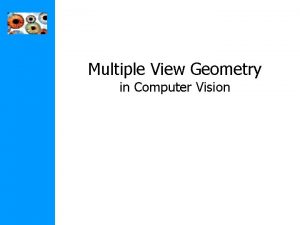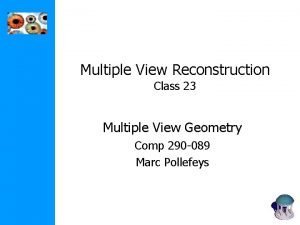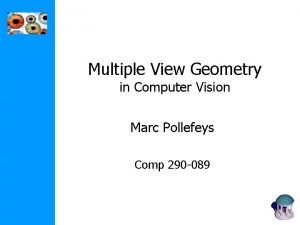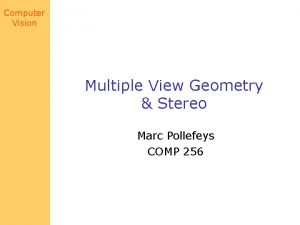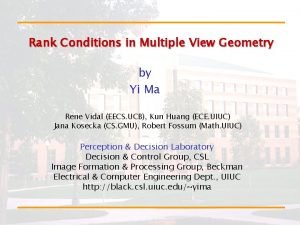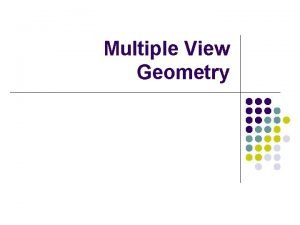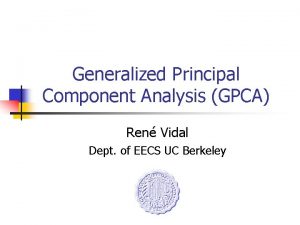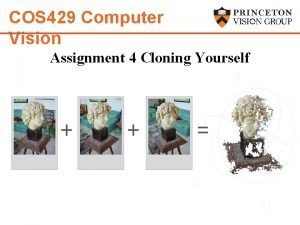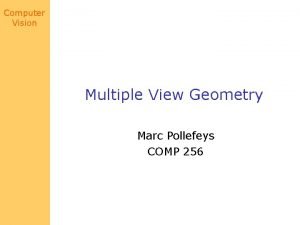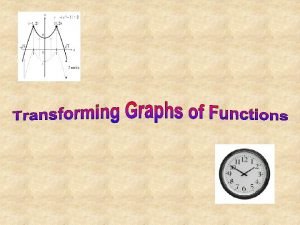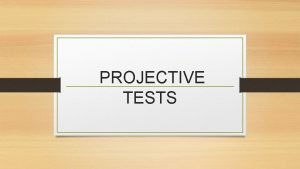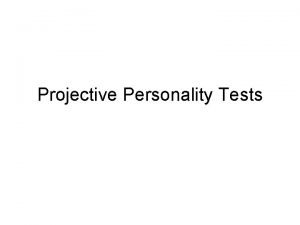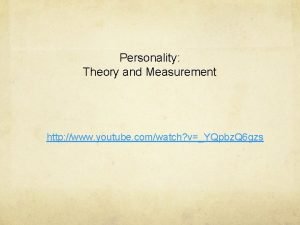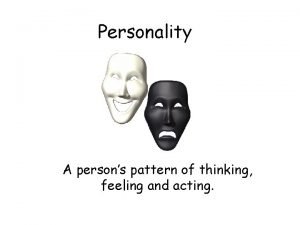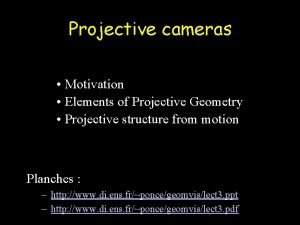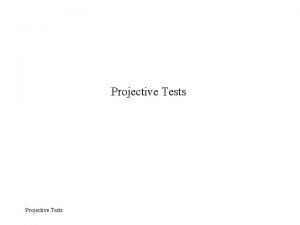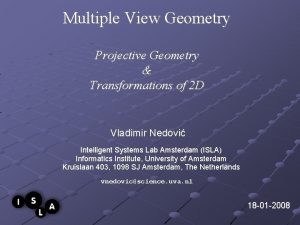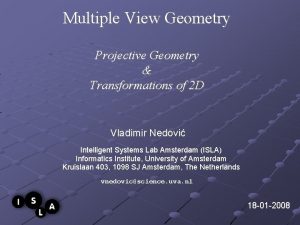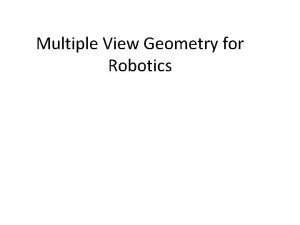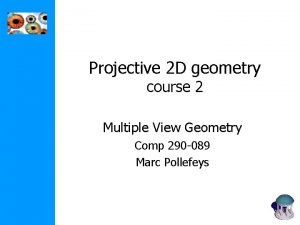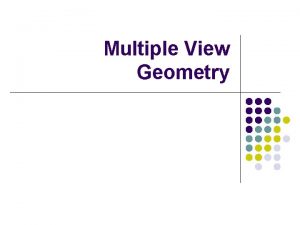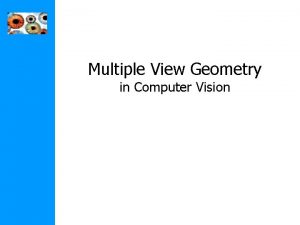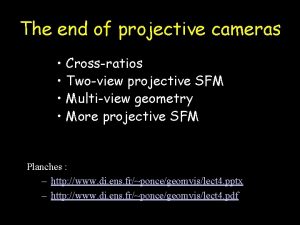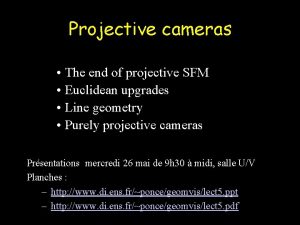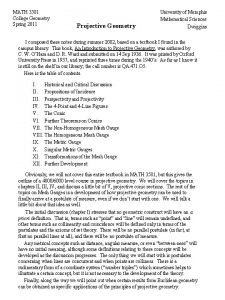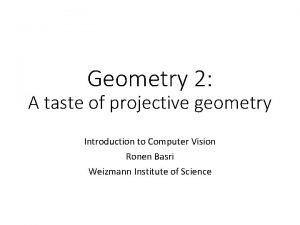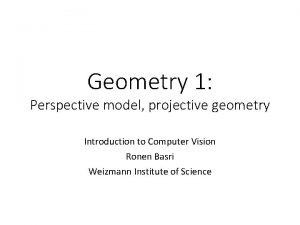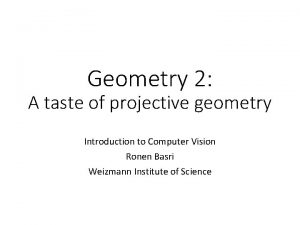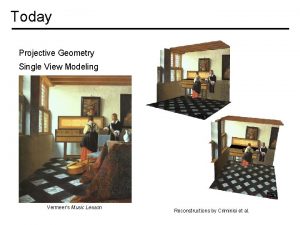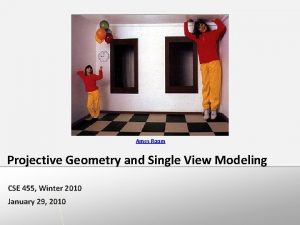Projective 2 D geometry course 2 Multiple View




























- Slides: 28

Projective 2 D geometry course 2 Multiple View Geometry Comp 290 -089 Marc Pollefeys

Content • Background: Projective geometry (2 D, 3 D), Parameter estimation, Algorithm evaluation. • Single View: Camera model, Calibration, Single View Geometry. • Two Views: Epipolar Geometry, 3 D reconstruction, Computing F, Computing structure, Plane and homographies. • Three Views: Trifocal Tensor, Computing T. • More Views: N-Linearities, Multiple view reconstruction, Bundle adjustment, autocalibration, Dynamic Sf. M, Cheirality, Duality

Multiple View Geometry course schedule (tentative) Jan. 7, 9 Intro & motivation Projective 2 D Geometry Jan. 14, 16 (no course) Projective 2 D Geometry Jan. 21, 23 Projective 3 D Geometry Parameter Estimation Jan. 28, 30 Parameter Estimation Algorithm Evaluation Camera Models Camera Calibration Feb. 11, 13 Single View Geometry Epipolar Geometry Feb. 18, 20 3 D reconstruction Fund. Matrix Comp. Feb. 25, 27 Structure Comp. Planes & Homographies Trifocal Tensor Three View Reconstruction Mar. 18, 20 Multiple View Geometry Multiple. View Reconstruction Mar. 25, 27 Bundle adjustment Papers Apr. 1, 3 Auto-Calibration Papers Apr. 8, 10 Dynamic Sf. M Papers Apr. 15, 17 Cheirality Papers Apr. 22, 24 Duality Project Demos Feb. 4, 6 Mar. 4, 6

Projective 2 D Geometry • Points, lines & conics • Transformations & invariants • 1 D projective geometry and the Cross-ratio

Homogeneous coordinates Homogeneous representation of lines equivalence class of vectors, any vector is representative Set of all equivalence classes in R 3 (0, 0, 0)T forms P 2 Homogeneous representation of points on if and only if The point x lies on the line l if and only if x. Tl=l. Tx=0 Homogeneous coordinates Inhomogeneous coordinates but only 2 DOF

Points from lines and vice-versa Intersections of lines The intersection of two lines and is Line joining two points The line through two points Example and is

Ideal points and the line at infinity Intersections of parallel lines Example tangent vector normal direction Ideal points Line at infinity Note that in P 2 there is no distinction between ideal points and others

A model for the projective plane exactly one line through two points exaclty one point at intersection of two lines

Duality principle: To any theorem of 2 -dimensional projective geometry there corresponds a dual theorem, which may be derived by interchanging the role of points and lines in the original theorem

Conics Curve described by 2 nd-degree equation in the plane or homogenized or in matrix form with 5 DOF:

Five points define a conic For each point the conic passes through or stacking constraints yields

Tangent lines to conics The line l tangent to C at point x on C is given by l=Cx x l C

Dual conics A line tangent to the conic C satisfies In general (C full rank): Dual conics = line conics = conic envelopes

Degenerate conics A conic is degenerate if matrix C is not of full rank e. g. two lines (rank 2) e. g. repeated line (rank 1) Degenerate line conics: 2 points (rank 2), double point (rank 1) Note that for degenerate conics

Projective transformations Definition: A projectivity is an invertible mapping h from P 2 to itself such that three points x 1, x 2, x 3 lie on the same line if and only if h(x 1), h(x 2), h(x 3) do. Theorem: A mapping h: P 2 is a projectivity if and only if there exist a non-singular 3 x 3 matrix H such that for any point in P 2 reprented by a vector x it is true that h(x)=Hx Definition: Projective transformation or 8 DOF projectivity=collineation=projective transformation=homography

Mapping between planes central projection may be expressed by x’=Hx (application of theorem)

Removing projective distortion select four points in a plane with know coordinates (linear in hij) (2 constraints/point, 8 DOF 4 points needed) Remark: no calibration at all necessary, better ways to compute (see later)

More examples

Transformation of lines and conics For a point transformation Transformation for lines Transformation for conics Transformation for dual conics

A hierarchy of transformations Projective linear group Affine group (last row (0, 0, 1)) Euclidean group (upper left 2 x 2 orthogonal) Oriented Euclidean group (upper left 2 x 2 det 1) Alternative, characterize transformation in terms of elements or quantities that are preserved or invariant e. g. Euclidean transformations leave distances unchanged

Class I: Isometries (iso=same, metric=measure) orientation preserving: orientation reversing: 3 DOF (1 rotation, 2 translation) special cases: pure rotation, pure translation Invariants: length, angle, area

Class II: Similarities (isometry + scale) 4 DOF (1 scale, 1 rotation, 2 translation) also know as equi-form (shape preserving) metric structure = structure up to similarity (in literature) Invariants: ratios of length, angle, ratios of areas, parallel lines

Class III: Affine transformations 6 DOF (2 scale, 2 rotation, 2 translation) non-isotropic scaling! (2 DOF: scale ratio and orientation) Invariants: parallel lines, ratios of parallel lengths, ratios of areas

Class VI: Projective transformations 8 DOF (2 scale, 2 rotation, 2 translation, 2 line at infinity) Action non-homogeneous over the plane Invariants: cross-ratio of four points on a line (ratio of ratio)

Action of affinities and projectivities on line at infinity Line at infinity stays at infinity, but points move along line Line at infinity becomes finite, allows to observe vanishing points, horizon,

Decomposition of projective transformations decomposition unique (if chosen s>0) Example: upper-triangular,

Overview transformations Projective 8 dof Concurrency, collinearity, order of contact (intersection, tangency, inflection, etc. ), cross ratio Affine 6 dof Parallellism, ratio of areas, ratio of lengths on parallel lines (e. g midpoints), linear combinations of vectors (centroids). The line at infinity l∞ Similarity 4 dof Euclidean 3 dof Ratios of lengths, angles. The circular points I, J lengths, areas.

Number of invariants? The number of functional invariants is equal to, or greater than, the number of degrees of freedom of the configuration less the number of degrees of freedom of the transformation e. g. configuration of 4 points in general position has 8 dof (2/pt) and so 4 similarity, 2 affinity and zero projective invariants
 Absolute conic
Absolute conic Multiple view geometry in computer vision
Multiple view geometry in computer vision Multiple view geometry
Multiple view geometry Quadrifocal
Quadrifocal Multiple view geometry in computer vision solution manual
Multiple view geometry in computer vision solution manual Multiple view geometry
Multiple view geometry Epipolar line
Epipolar line Multiple view geometry
Multiple view geometry Multiple view geometry
Multiple view geometry Tensor notation
Tensor notation Lewis structures and molecular geometry
Lewis structures and molecular geometry Electron domain geometry vs molecular geometry
Electron domain geometry vs molecular geometry The basis of the vsepr model of molecular bonding is
The basis of the vsepr model of molecular bonding is Multiple transformations geometry
Multiple transformations geometry Delayed multiple baseline design
Delayed multiple baseline design Shared memory mimd architecture
Shared memory mimd architecture Bandura's reciprocal determinism
Bandura's reciprocal determinism Define projective test in psychology
Define projective test in psychology Projective testing
Projective testing Tests that present ambiguous stimuli
Tests that present ambiguous stimuli Projective test definition psychology
Projective test definition psychology Youtube
Youtube The barnum effect
The barnum effect Object relations
Object relations Projective labelling
Projective labelling Projective techniques in exploratory research
Projective techniques in exploratory research Identification defense mechanism
Identification defense mechanism Projective test example
Projective test example Raymond cattell ap psychology
Raymond cattell ap psychology

